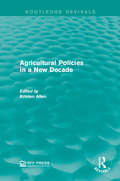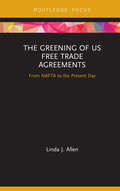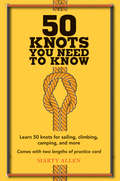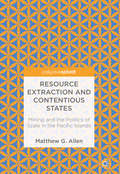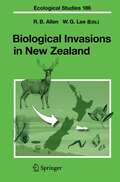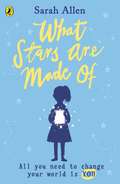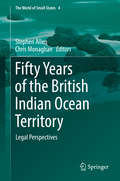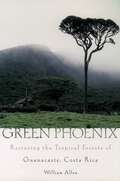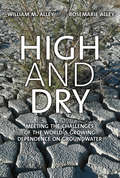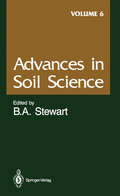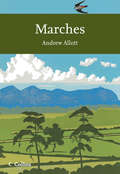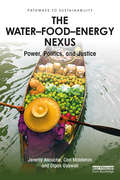- Table View
- List View
Agricultural Policies in a New Decade (Routledge Revivals)
by Kristen AllenAgricultural Policies in a New Decade was written in preparation for the 1990 Farm Bill in the United States in collaboration with the Food and Agriculture Committee of the National Planning Association. Originally published in the same year, this study aims to inform on the key issues affecting the new bill including budget austerity, the effects of agriculture on environmental quality, the safety and security of the U.S. food supply and international markets and trade policy. This title will be of interest to students of Environmental Studies and policy makers.
Agricultural Policies in a New Decade (Routledge Revivals)
by Kristen AllenAgricultural Policies in a New Decade was written in preparation for the 1990 Farm Bill in the United States in collaboration with the Food and Agriculture Committee of the National Planning Association. Originally published in the same year, this study aims to inform on the key issues affecting the new bill including budget austerity, the effects of agriculture on environmental quality, the safety and security of the U.S. food supply and international markets and trade policy. This title will be of interest to students of Environmental Studies and policy makers.
U.S.-Canadian Agricultural Trade Challenges: Developing Common Approaches (Routledge Revivals)
by Kristen Allen Katie MacmillanThe Free Trade Agreement between the United States and Canada was established in 1988 despite the U.S.’s controversial proposal to eliminate trade-distorting government subsidies to agriculture. Originally published in 1988, this volume brings together a collection of essays which identify and debate the difficulties associated with agricultural trade between the U.S. and Canada and explore common interests in the resolution of global agricultural issues. This title is a valuable resource for students interested in environmental studies and international agricultural relations.
U.S.-Canadian Agricultural Trade Challenges: Developing Common Approaches (Routledge Revivals)
by Kristen Allen Katie MacmillanThe Free Trade Agreement between the United States and Canada was established in 1988 despite the U.S.’s controversial proposal to eliminate trade-distorting government subsidies to agriculture. Originally published in 1988, this volume brings together a collection of essays which identify and debate the difficulties associated with agricultural trade between the U.S. and Canada and explore common interests in the resolution of global agricultural issues. This title is a valuable resource for students interested in environmental studies and international agricultural relations.
The Greening of US Free Trade Agreements: From NAFTA to the Present Day (Routledge Focus on Environment and Sustainability)
by Linda AllenThis book provides an up-to-date critical analysis of the integration of environmental policies into US free trade agreements. The work focuses on the evolution of the design of environmental policies and analyzes their effectiveness. Starting with the North American Free Trade Agreement (NAFTA) leading to the Trans-Pacific Partnership (TPP), the book examines the history of policy integration. In doing so, it provides an overview of the major trade-related environmental policies and presents empirical research on their effectiveness, a discussion of the continued demand for policy integration in light of the effectiveness, and recommendations for addressing shortcomings. The main objective of the book is to inform the ongoing policy debate over integration of environmental policies into trade agreements. The current renegotiation of NAFTA provides an opportune time for undertaking this critical review of trade-related environmental policies. As our understanding and knowledge of the environmental policies associated with US trade agreements, in particular for NAFTA, has grown significantly over the past twenty-five years, this book provides a timely and critical update for this policy debate. Students and scholars of environmental law, trade and economics, and specifically US trade, environmental policy and law will find this book of great interest.
The Greening of US Free Trade Agreements: From NAFTA to the Present Day (Routledge Focus on Environment and Sustainability)
by Linda AllenThis book provides an up-to-date critical analysis of the integration of environmental policies into US free trade agreements. The work focuses on the evolution of the design of environmental policies and analyzes their effectiveness. Starting with the North American Free Trade Agreement (NAFTA) leading to the Trans-Pacific Partnership (TPP), the book examines the history of policy integration. In doing so, it provides an overview of the major trade-related environmental policies and presents empirical research on their effectiveness, a discussion of the continued demand for policy integration in light of the effectiveness, and recommendations for addressing shortcomings. The main objective of the book is to inform the ongoing policy debate over integration of environmental policies into trade agreements. The current renegotiation of NAFTA provides an opportune time for undertaking this critical review of trade-related environmental policies. As our understanding and knowledge of the environmental policies associated with US trade agreements, in particular for NAFTA, has grown significantly over the past twenty-five years, this book provides a timely and critical update for this policy debate. Students and scholars of environmental law, trade and economics, and specifically US trade, environmental policy and law will find this book of great interest.
50 Knots You Need to Know: Learn 50 knots for sailing, climbing, camping, and more
by Marty AllenEssential rope-and-string tying advice for the nerdily inclined. Includes two lengths of rope to help you practice tying knots. Attention all nerds, put down that laptop and pick up this brilliant guide to tying 50 must-know knots. If you're unaware of the difference between a Cow Hitch and a Marlinspike Hoop or a Running Bowline and a Square Lashing, all will be revealed in "50 Knots You Need to Know." Packed with step-by-step instructions, discover how to tie knots to get you through any situation, whether it's nautical knots for sailing adventures or shanks and hitches for camping or climbing weekends. You will learn simple knot-making techniques that can be used for all your nerdly pursuits. And once you've graduated from the easy stuff you can move on to the more serious examples, such as a make-shift rope halter to you can use to tame a wild beast or strong knots for securing and tying things together. Also included are a couple of pieces of rope, so you can start tying knows right away. But be warned, it's VERY addictive!
Resource Extraction and Contentious States: Mining And The Politics Of Scale In The Pacific Islands
by Matthew G. AllenMining And The Politics Of Scale In The Pacific Islands
Biological Invasions in New Zealand (Ecological Studies #186)
by Robert B. Allen William G. LeeHuman colonization of New Zealand has dramatically altered the resident biota, introduced numerous alien organisms to these once remote islands, and exported local species to the world. This book reviews invasions, investigates what controls the success of invaders and studies the consequences for ecosystems both on land and offshore. The book tests current theories about the success of invaders and evaluates principles for effective management of biological invasions worldwide.
What Stars Are Made Of
by Sarah AllenFrom the publishers who brought you Wonder, comes an astonishingly bold and moving middle-grade debut about family, friendship and how it's OK to be different. Libby wants to be a scientist when she grows up, just like her hero, the underrated astronomer Cecilia Payne. She'd also do anything for her family - and when her beloved big sister Nonny is in trouble, Libby comes up with the perfect plan to help her, and at the same time remind the world what stars are made of.
Fifty Years of the British Indian Ocean Territory: Legal Perspectives (The World of Small States #4)
by Stephen Allen Chris MonaghanThis book offers a detailed account of the legal issues concerning the British Indian Ocean Territory (Chagos Islands) by leading experts in the field. It examines the broader significance of the ongoing Bancoult litigation in the UK Courts, the Chagos Islanders' petition to the European Court of Human Rights and Mauritius' successful challenge, under the UN Convention of the Law of the Sea, to the UK government's creation of a Marine Protected Area around the Chagos Archipelago. This book, produced in response to the 50th anniversary of the BIOT's founding, also assesses the impact of the decisions taken in respect of the Territory against a wider background of decolonization while addressing important questions about the lawfulness of maintaining Overseas Territories in the post-colonial era.The chapter ‘Anachronistic As Colonial Remnants May Be...’ - Locating the Rights of the Chagos Islanders As A Case Study of the Operation of Human Rights Law in Colonial Territories is open access under a CC BY 4.0 license via link.springer.com.
Green Phoenix: Restoring the Tropical Forests of Guanacaste, Costa Rica
by William AllenCan we prevent the destruction of the world's tropical forests? In the fire-scarred hills of Costa Rica, award-winning science writer William Allen found a remarkable answer: we can not only prevent their destruction--we can bring them back to their former glory. In Green Phoenix, Allen tells the gripping story of a large group of Costa Rican and American scientists and volunteers who set out to save the tropical forests in the northwestern section of the country. It was an area badly damaged by the fires of ranchers and small farmers; in many places a few strands of forest strung across a charred landscape. Despite the widely held belief that tropical forests, once lost, are lost forever, the team led by the dynamic Daniel Janzen from the University of Pennsylvania moved relentlessly ahead, taking a broad array of political, ecological, and social steps necessary for restoration. They began with 39 square miles and, by 2000, they had stitched together and revived some 463 square miles of land and another 290 of marine area. Today this region is known as the Guanacaste Conservation Area, a fabulously rich landscape of dry forest, cloud forest, and rain forest that gives life to some 235,000 species of plants and animals. It may be the greatest environmental success of our time, a prime example of how extensive devastation can be halted and reversed. This is an inspiring story, and in recounting it, Allen writes with vivid power. He creates lasting images of pristine beaches and dense forest and captures the heroics and skill of the scientific teams, especially the larger-than-life personality of the maverick ecologist Daniel Janzen. It is a book everyone concerned about the environment will want to own.
The Two-Mile Time Machine: Ice Cores, Abrupt Climate Change, and Our Future
by Richard B. AlleyIn the 1990s Richard B. Alley and his colleagues made headlines with the discovery that the last ice age came to an abrupt end over a period of only three years. In The Two-Mile Time Machine, Alley tells the fascinating history of global climate changes as revealed by reading the annual rings of ice from cores drilled in Greenland. He explains that humans have experienced an unusually temperate climate compared to the wild fluctuations that characterized most of prehistory. He warns that our comfortable environment could come to an end in a matter of years and tells us what we need to know in order to understand and perhaps overcome climate changes in the future.In a new preface, the author weighs in on whether our understanding of global climate change has altered in the years since the book was first published, what the latest research tells us, and what he is working on next.
The Two-Mile Time Machine: Ice Cores, Abrupt Climate Change, and Our Future
by Richard B. AlleyIn the 1990s Richard B. Alley and his colleagues made headlines with the discovery that the last ice age came to an abrupt end over a period of only three years. In The Two-Mile Time Machine, Alley tells the fascinating history of global climate changes as revealed by reading the annual rings of ice from cores drilled in Greenland. He explains that humans have experienced an unusually temperate climate compared to the wild fluctuations that characterized most of prehistory. He warns that our comfortable environment could come to an end in a matter of years and tells us what we need to know in order to understand and perhaps overcome climate changes in the future.In a new preface, the author weighs in on whether our understanding of global climate change has altered in the years since the book was first published, what the latest research tells us, and what he is working on next.
High and Dry: Meeting the Challenges of the World's Growing Dependence on Groundwater
by William M. Alley Rosemarie AlleyAn engaging call to understand and protect groundwater, the primary source of drinking water for almost half of the world’s population Groundwater is essential for drinking water and food security. It provides enormous environmental benefits by keeping streams and rivers flowing. But a growing global population, widespread use of industrial chemicals, and climate change threaten this vital resource. Groundwater depletion and contamination has spread from isolated areas to many countries throughout the world. In this accessible and timely book, hydrology expert William M. Alley and science writer Rosemarie Alley sound the call to protect groundwater. Drawing on examples from around the world, including case studies in the United States, Canada, Australia, India, and Sub-Saharan Africa, the authors examine groundwater from key scientific and socioeconomic perspectives. While addressing the serious nature of groundwater problems, the book includes stories of people who are making a difference in protecting this critical resource.
Forest Entomology and Pathology: Volume 1: Entomology
by Jeremy D. Allison Timothy D. Paine Bernard Slippers Michael J. WingfieldThis open access book will provide an introduction to forest entomology, the principles and techniques of forest insect pest management, the different forest insect guilds/feeding groups, and relevant forest insect pest management case studies. In addition to covering 30% of the earth, forest ecosystems provide numerous timber and non-timber products that affect our daily lives and recreational opportunities, habitat for diverse animal communities, watershed protection, play critical roles in the water cycle, and mitigate soil erosion and global warming. In addition to being the most abundant organisms in forest ecosystems, insects perform numerous functions in forests, many of which are beneficial and critical to forest health. Conversely, some insects damage and/or kill trees and reduce the capacity of forests to provide desired ecosystem services. The target audience of this book is upper-level undergraduate and graduate students and professionals interested in forest health and entomology.
Ecological Restoration and Environmental Change: Renewing Damaged Ecosystems
by Stuart K. AllisonWhat is a natural habitat? Who can define what is natural when species and ecosystems constantly change over time, with or without human intervention? When a polluted river or degraded landscape is restored from its damaged state, what is the appropriate outcome? With climate change now threatening greater disruption to the stability of ecosystems, how should restoration ecologists respond? Ecological Restoration and Environmental Change addresses and challenges some of these issues which question the core values of the science and practice of restoration ecology. It analyzes the paradox arising from the desire to produce ecological restorations that fit within an historical ecological context, produce positive environmental benefits and also result in landscapes with social meaning. Traditionally restorationists often felt that by producing restorations that matched historic ecosystems they were following nature's plans and human agency played only a small part in restoration. But the author shows that in reality the process of restoration has always been defined by human choices. He examines the development of restoration practice, especially in North America, Europe and Australia, in order to describe different models of restoration with respect to balancing ecological benefit and cultural value. He develops ways to balance more actively these differing areas of concern while planning restorations. The book debates in detail how coming global climate change and the development of novel ecosystems will force us to ask new questions about what we mean by good ecological restoration. When the environment is constantly shifting, restoration to maintain biodiversity, local species, and ecosystem functions becomes even more challenging. It is likely that in the future ecological restoration will become a never-ending, continuously evolving process.
Ecological Restoration and Environmental Change: Renewing Damaged Ecosystems
by Stuart K. AllisonWhat is a natural habitat? Who can define what is natural when species and ecosystems constantly change over time, with or without human intervention? When a polluted river or degraded landscape is restored from its damaged state, what is the appropriate outcome? With climate change now threatening greater disruption to the stability of ecosystems, how should restoration ecologists respond? Ecological Restoration and Environmental Change addresses and challenges some of these issues which question the core values of the science and practice of restoration ecology. It analyzes the paradox arising from the desire to produce ecological restorations that fit within an historical ecological context, produce positive environmental benefits and also result in landscapes with social meaning. Traditionally restorationists often felt that by producing restorations that matched historic ecosystems they were following nature's plans and human agency played only a small part in restoration. But the author shows that in reality the process of restoration has always been defined by human choices. He examines the development of restoration practice, especially in North America, Europe and Australia, in order to describe different models of restoration with respect to balancing ecological benefit and cultural value. He develops ways to balance more actively these differing areas of concern while planning restorations. The book debates in detail how coming global climate change and the development of novel ecosystems will force us to ask new questions about what we mean by good ecological restoration. When the environment is constantly shifting, restoration to maintain biodiversity, local species, and ecosystem functions becomes even more challenging. It is likely that in the future ecological restoration will become a never-ending, continuously evolving process.
Ecological Restoration and Environmental Change: Renewing Damaged Ecosystems
by Stuart K. AllisonEcological Restoration and Environmental Change presents an introduction to the practice of renewing and restoring degraded, damaged, or destroyed ecosystems and habitats in the environment. The book addresses and challenges key issues which question the core values of the science and practice of restoration ecology. The author explains that the process of restoration has always been defined by human choices and examines the development of restoration practice, to describe different models of restoration with respect to balancing ecological benefit and cultural value. He develops ways to balance more actively these differing areas of concern while planning restorations. This new edition has been fully revised and updated to reflect changes in the field and the new challenges posed to restoration ecology in the face of the rapid pace of climate change. With strong coverage of North and South American, Europe, and Australia, this new edition has been expanded to also address indigenous perspectives and restoration projects in Africa, the Pacific Islands, and Asia. It places special emphasis on the need for restorationists to appreciate and understand the intricacies of planning and managing restorations in novel ecosystems. Lastly, it provides a critique of the new restoration standards published by the Society for Ecological Restoration in 2019. This book is essential reading for students on restoration ecology and conservation courses, as well as professionals and practitioners working on restoration projects.
Ecological Restoration and Environmental Change: Renewing Damaged Ecosystems
by Stuart K. AllisonEcological Restoration and Environmental Change presents an introduction to the practice of renewing and restoring degraded, damaged, or destroyed ecosystems and habitats in the environment. The book addresses and challenges key issues which question the core values of the science and practice of restoration ecology. The author explains that the process of restoration has always been defined by human choices and examines the development of restoration practice, to describe different models of restoration with respect to balancing ecological benefit and cultural value. He develops ways to balance more actively these differing areas of concern while planning restorations. This new edition has been fully revised and updated to reflect changes in the field and the new challenges posed to restoration ecology in the face of the rapid pace of climate change. With strong coverage of North and South American, Europe, and Australia, this new edition has been expanded to also address indigenous perspectives and restoration projects in Africa, the Pacific Islands, and Asia. It places special emphasis on the need for restorationists to appreciate and understand the intricacies of planning and managing restorations in novel ecosystems. Lastly, it provides a critique of the new restoration standards published by the Society for Ecological Restoration in 2019. This book is essential reading for students on restoration ecology and conservation courses, as well as professionals and practitioners working on restoration projects.
Routledge Handbook of Ecological and Environmental Restoration
by Stuart K. Allison Stephen D. MurphyEcological restoration is a rapidly evolving discipline that is engaged with developing both methodologies and strategies for repairing damaged and polluted ecosystems and environments. During the last decade the rapid pace of climate change coupled with continuing habitat destruction and the spread of non-native species to new habitats has forced restoration ecologists to re-evaluate their goals and the methods they use. This comprehensive handbook brings together an internationally respected group of established and rising experts in the field. The book begins with a description of current practices and the state of knowledge in particular areas of restoration, and then identifies new directions that will help the field achieve increasing levels of future success. Part I provides basic background about ecological and environmental restoration. Part II systematically reviews restoration in key ecosystem types located throughout the world. In Part III, management and policy issues are examined in detail, offering the first comprehensive treatment of policy relevance in the field, while Part IV looks to the future. Ultimately, good ecological restoration depends upon a combination of good science, policy, planning and outreach – all issues that are addressed in this unrivalled volume.
Routledge Handbook of Ecological and Environmental Restoration
by Stuart K. Allison Stephen D. MurphyEcological restoration is a rapidly evolving discipline that is engaged with developing both methodologies and strategies for repairing damaged and polluted ecosystems and environments. During the last decade the rapid pace of climate change coupled with continuing habitat destruction and the spread of non-native species to new habitats has forced restoration ecologists to re-evaluate their goals and the methods they use. This comprehensive handbook brings together an internationally respected group of established and rising experts in the field. The book begins with a description of current practices and the state of knowledge in particular areas of restoration, and then identifies new directions that will help the field achieve increasing levels of future success. Part I provides basic background about ecological and environmental restoration. Part II systematically reviews restoration in key ecosystem types located throughout the world. In Part III, management and policy issues are examined in detail, offering the first comprehensive treatment of policy relevance in the field, while Part IV looks to the future. Ultimately, good ecological restoration depends upon a combination of good science, policy, planning and outreach – all issues that are addressed in this unrivalled volume.
Advances in Soil Science (Advances in Soil Science #6)
by R. R. Allmaras S. C. Gupta J. Kubota A. D. Scott S. J. Smith D. L. Sparks M. E. Sumner D. Van Campen J. L. Walworth R. M. WelchThe world needs for food and fiber continue to increase. Population growth in the developing countries peaked at 2. 4 percent a year in 1965 and has fallen to about 2. I percent. However, in many developing countries almost half the people are under 15 years of age, poised to enter their productive and reproductive years. The challenges to produce enough food for this growing population will remain great. Even more challenging is growing the food in the areas of greatest need. Presently the world has great surpluses of food and fiber in some areas while there are devastating deficiencies in other areas. Economic conditions and the lack of suitable infrastructure for distribution all too often limit the alleviation of hunger even when there are adequate supplies, sometimes even within the country itself. World hunger can only be solved in the long run by increasing crop production in the areas where the population is growing most rapidly. This will require increased efforts of both the developed and developing countries. Much of the technology that is so successful for crop production in the developed countries cannot be utilized directly in the developing countries. Many of the principles, however, can and must be adapted to the conditions, both physical and economic, of the developing countries. This series, Advances in Soil Science.
Marches (Collins New Naturalist Library #118)
by Andrew AllottA complete natural history and the first large-scale survey of this unique part of the country.
The Water–Food–Energy Nexus: Power, Politics, and Justice (Pathways to Sustainability)
by Jeremy Allouche Carl Middleton Dipak GyawaliThe world of development thinkers and practitioners is abuzz with a new lexicon: the idea of "the nexus" between water, food, and energy which is intuitively compelling. It promises better integration of multiple sectoral elements, a better transition to greener economies, and sustainable development. However, there appears to be little agreement on its precise meaning, whether it only complements existing environmental governance approaches or how it can be enhanced in national contexts. One current approach to the nexus treats it as a risk and security matter while another treats it within economic rationality addressing externalities across sector. A third perspective acknowledges it as a fundamentally political process requiring negotiation amongst different actors with distinct perceptions, interests, and practices. This perspective highlights the fact that technical solutions for improving coherence within the nexus may have unintended and negative impacts in other policy areas, such as poverty alleviation and education. The Water–Food–Energy Nexus: Power, Politics and Justice lays out the managerial-technical definitions of the nexus and challenges these conceptions by bringing to the forefront the politics of the nexus, around two key dimensions – a dynamic understanding of water–food–energy systems, and a normative positioning around nexus debates, in particular around social justice. The authors argue that a shift in nexus governance is required towards approaches where limits to control are acknowledged, and more reflexive/plural strategies adopted. This book will be of interest to academic researchers, policy makers, and practitioners in the fields of international development studies, environmental politics, and science and technology studies, as well as international relations.
